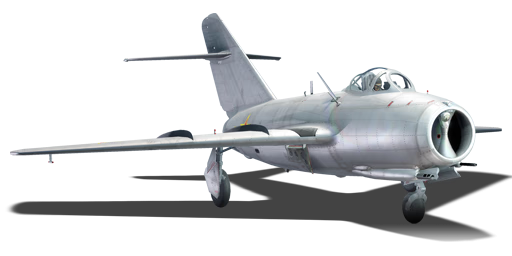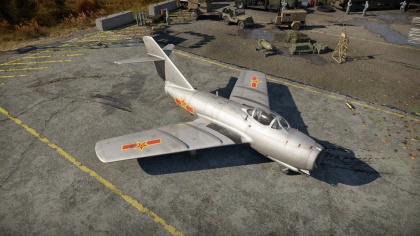J-2
Contents
| This page is about the Chinese jet fighter J-2. For other variants, see MiG-15 (Family). |
Description
The J-2 is a rank V Chinese jet fighter
with a battle rating of 8.7 (AB/SB) and 8.3 (RB). It was introduced in Update 1.91 "Night Vision". It is a Chinese version of the MiG-15bis and performs identically to it.
General info
Flight performance
| Characteristics | Max Speed (km/h at 0 m - sea level) |
Max altitude (metres) |
Turn time (seconds) |
Rate of climb (metres/second) |
Take-off run (metres) | |||
|---|---|---|---|---|---|---|---|---|
| AB | RB | AB | RB | AB | RB | |||
| Stock | 1,061 | 1,046 | 15500 | 21.0 | 22.0 | 41.4 | 39.8 | 475 |
| Upgraded | 1,087 | 1,076 | 20.4 | 20.7 | 59.7 | 50.0 | ||
Details
| Features | |||||
|---|---|---|---|---|---|
| Combat flaps | Take-off flaps | Landing flaps | Air brakes | Arrestor gear | Drogue chute |
| X | ✓ | ✓ | ✓ | X | X |
| Limits | ||||||
|---|---|---|---|---|---|---|
| Wings (km/h) | Gear (km/h) | Flaps (km/h) | Max Static G | |||
| Combat | Take-off | Landing | + | - | ||
| 0 | 450 | N/A | 650 | 450 | ~12 | ~6 |
| Optimal velocities (km/h) | |||
|---|---|---|---|
| Ailerons | Rudder | Elevators | Radiator |
| < 600 | < 700 | < 750 | N/A |
Engine performance
| Engine | Aircraft mass | |||||
|---|---|---|---|---|---|---|
| Engine name | Number | Empty mass | Wing loading (full fuel) | |||
| Klimov VK-1 | 1 | 3,648 kg | 233 kg/m2 | |||
| Engine characteristics | Mass with fuel (no weapons load) | Max Takeoff Weight | ||||
| Weight (each) | Type | 8m fuel | 20m fuel | 28m fuel | ||
| 892 kg | Centrifugal-flow turbojet | 3,980 kg | 4,478 kg | 4,810 kg | 5,485 kg | |
| Maximum engine thrust @ 0 m (RB / SB) | Thrust to weight ratio @ 0 m (100%) | |||||
| Condition | 100% | WEP | 8m fuel | 20m fuel | 28m fuel | MTOW |
| Stationary | 2,450 kgf | N/A | 0.62 | 0.55 | 0.51 | 0.45 |
| Optimal | 2,450 kgf (0 km/h) |
N/A | 0.62 | 0.55 | 0.51 | 0.45 |
Survivability and armour
- 10 mm steel armour plates in front of the cockpit and behind the pilot's head rest.
- 64 mm bulletproof glass front windshield.
- Self-sealing fuel tanks behind the pilot and under the jet engine nozzle.
- Jet engine located in the rear of the aircraft, pilot seated in front.
Armaments
Offensive armament
The J-2 is armed with:
- 1 x 37 mm N-37D cannon, chin-mounted (40 rpg)
- 2 x 23 mm NR-23 cannons, chin-mounted (80 rpg = 160 total)
Suspended armament
The J-2 can be outfitted with the following ordnance:
- Without load
- 2 x 100 kg FAB-100M-43 bombs (200 kg total)
- 2 x 250 kg FAB-250M-46 bombs (500 kg total)
- 16 x S-5K rockets
- 16 x S-5M rockets
- 2 x S-21 rockets
Usage in battles
At higher ranks of the Chinese aviation line, the J-2, which is a reverse-engineered MiG-15 series, is one of the most iconic jet fighter aircraft designs from after the Second World War. Earning its reputation on fame over the skies of Korea against its US contemporary, the F-86 Sabre.
The J-2 features a powerful cannon arrangement of 2 x 23 mm and 1x 37 mm, excellent high altitude performance and is highly effective in vertical manoeuvres. Unlike the MiG-9 that comes before it, the J-2 is also the first jet aircraft in the Chinese tree to feature an air brake which is extremely useful in combat situations. The jet fighter does, however, have its downsides. The lack of an "all-flying tailplane" (such as that featured on the Sabre) leads to less control over the aircraft at higher speeds approaching 1,000 km/h. While the MiG is initially faster in acceleration by comparison to the Sabre, this does mean that once both aircraft are up at higher speeds, the Sabre will hold some advantages over the J-2. It should be noted that if you load 8 minutes of fuel instead of the regular (for most pilots) 20, it drastically improves your performance. However, this is not recommended to be done at the beginning of the match as most matches last longer than 8 minutes, and should instead be done when you land mid-match.
The combination of 37 mm and 23 mm cannons creates aiming issues for pilots not familiar with their ballistic properties or velocity. Due to the size of these cannons, ammunition pools are restricted by comparison to other top tier jet aircraft. To help compensate the two different trajectories of the armament, it is recommended to use 'rolling' manoeuvres, as the rudder may lock in high speeds. To aim with these cannons, it is best to estimate the lead with the experience built up with planes beforehand (eg. La-9) and add extra distance over the estimated lead (about double from the estimated).
Once pilots have learned to use the J-2's excellent rate of climb, acceleration and high altitude capabilities to their advantage, the downsides of the aircraft are far less significant than the positives. In the right hands, theJ-2 can be a devastating combatant, capable of dealing with any aircraft in-game swiftly. Teamwork, squads, and communication will also be beneficial when flying the J-2 as effective coordination between multiple pilots allow you to use this aircraft to its maximum potential. After mastering the J-2, you can research its improved variant, the J-4 (reverse-engineered MiG-17). The J-2 shares much of its performance abilities and issues.
Modules
| Tier | Flight performance | Survivability | Weaponry | |||
|---|---|---|---|---|---|---|
| I | Fuselage repair | Compressor | Offensive 23 mm | |||
| II | New boosters | Airframe | New 23 mm cannons | S5K | ||
| III | Wings repair | Offensive 37 mm | S5M | BD-2-48 | ||
| IV | G-suit | Engine | Cover | New 37 mm cannons | S21 | |
Pros and cons
Pros:
- Flaps can be deployed at high speeds
- Capable and useful air brake
- High rate of climb
- Great acceleration
- Deadly armament capable of making snapshots
- Large calibre cannons and their high one-second burst mass makes quick deflection shots easier
- Excellent energy retention
- Has a gyro gunsight, allowing more accurate lead
Cons:
- Abysmal roll rate
- Poor turning circle
- Compression at high speeds
- Poor visibility over the nose as the gunsight blocks the view
- Extremely challenging to use when stock
- Armament difficult to use (low velocities, low ammo and two different trajectories)
- Guns tend to spark a lot (the N-37 in particular)
- No G-suit, so maintaining control is difficult when turning at high speeds
- Has a thick piece of cockpit frame above the gunsight, creating inconveniences and obstructions in a battle
History
In-game description
After World War II was over, the leaders of the USSR realized that they were behind the leading states of the world in the sphere of jet aircraft construction, most notably in the full-scale production of turbojet engines. Consequently, a delegation including the designers A. I. Mikoyan and V. Y. Klimov was sent to Great Britain towards the end of 1946. Their negotiations were successful, resulting in the purchase of two of the most advanced turbojet engines at that time: the Rolls-Royce Derwent Mk.V and the Rolls-Royce Nene I/Nene II. The British consented to sell their newest strategic designs easily enough, since they believed that the Soviet industrial/technological apparatus could not handle the mass production of sophisticated assemblies. However, very soon that the Rolls-Royce engines were launched into full-scale Soviet production under the designations RD-500 and RD-45.
The emergence of the new engines led to the creation of Soviet jet fighters able to compete with the leading models of the world. In 1947, the Mikoyan Design Bureau started the development of a front line fighter with a Nene (RD-45) turbojet engine and an airtight cockpit: the I-310 ("S"). The first S-01 prototype aircraft made its first flight on December 30, 1947, and, after working on the test results, was launched into full-scale production in 1948 under the designation MiG-15. The plane's airframe was an all-metal monoplane configuration with mid-swept wings and empennage. Thus the MiG-15 became the first production swept-wing fighter.
The MiG-15 was equipped with a RD-45F single-shaft turbojet engine rated at 2,270 kg of thrust with a double-entry centrifugal compressor. The plane's armament included a 37mm Nudelman N-37D cannon with 40 rounds and two 23mm Nudelman-Suranov NS-23KM guns with 160 rounds in total. The cannons were mounted in the forward fuselage on a lowerable carriage. Two 100-kg or 50-kg bombs could be suspended under the wings. To increase its flight range, the aircraft could carry two external fuel tanks with a capacity ranging from 250 to 600 liters.
The MiG-15 fighter was notable for its simple and reliable structure, high flight and operating characteristics, and powerful armament. Its maximum speed, rate of climb, ceiling, and flight range were the best among Soviet fighters at the time and superior to many foreign aircraft, as well.
The first production MiG-15s with RD-45F engines began to leave the factory floor in early 1949. In 1950, more advanced MiG-15bis fighters replaced them in the factory assembly lines.
Media
Excellent additions to the article would be video guides, screenshots from the game, and photos.
See also
Links to the articles on the War Thunder Wiki that you think will be useful for the reader, for example:
- reference to the series of the aircraft;
- links to approximate analogues of other nations and research trees.
External links
Paste links to sources and external resources, such as:
- topic on the official game forum;
- encyclopedia page on the aircraft;
- other literature.
| Shenyang Aircraft Corporation (中航工业沈阳飞机工业(集团)有限公司) | |
|---|---|
| Jet Fighters | |
| MiG-15 | J-2* |
| MiG-17 | J-4* |
| MiG-19 | J-6A* |
| J-8 | J-8B · J-8F |
| Su-27 variants | J-11* · J-11A* |
| Export | Shenyang F-5* |
| *Licensed Note: "J-2" and "J-4" are not official designations | |
| See Also | Mikoyan-Gurevich Design Bureau |
| China jet aircraft | |
|---|---|
| Fighters | J-2 · J-4 · J-6A · J-7II · J-7D · J-7E · J-8B · J-8F · J-10A · J-11 · J-11A |
| Strike aircraft | Q-5 early · Q-5A · Q-5L · JH-7A |
| Bombers | H-5 |
| France | ␗Mirage 2000-5Ei |
| USA | ␗F-84G-21-RE · ␗F-84G-31-RE · ␗F-86F-30 · ␗F-86F-40 · ␗F-100A · ␗F-100F · ␗F-104A · ␗F-104G · ␗F-5A · ␗F-5E · ␗F-16A MLU |
| USSR | ␗MiG-9 · ␗MiG-9 (l) |
| North Korea | Shenyang F-5 |
| Pakistan | A-5C · JF-17 |





